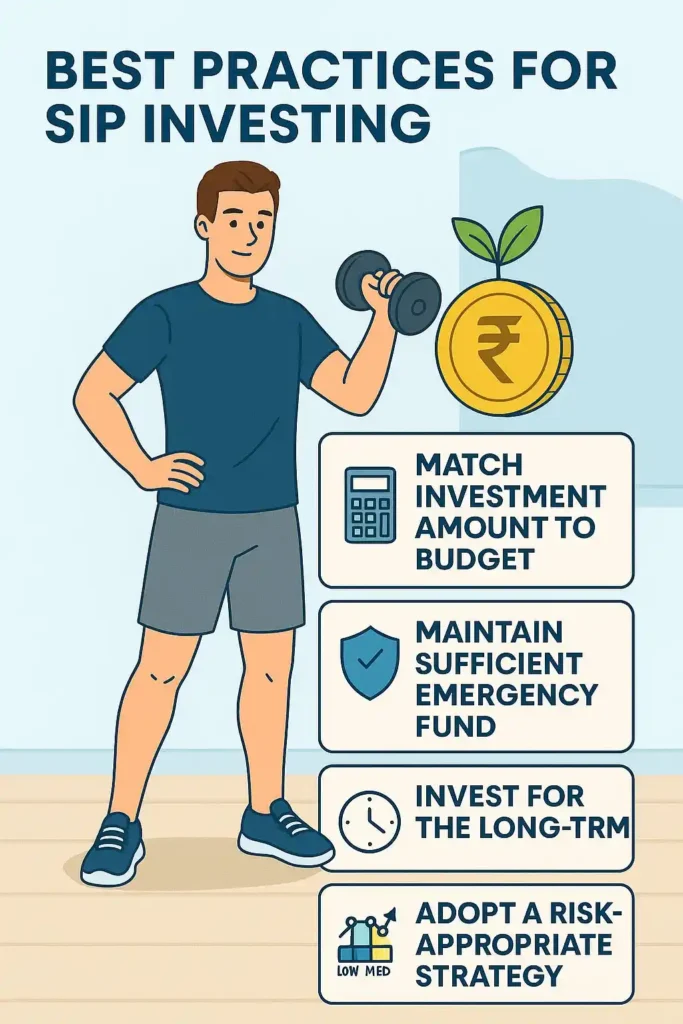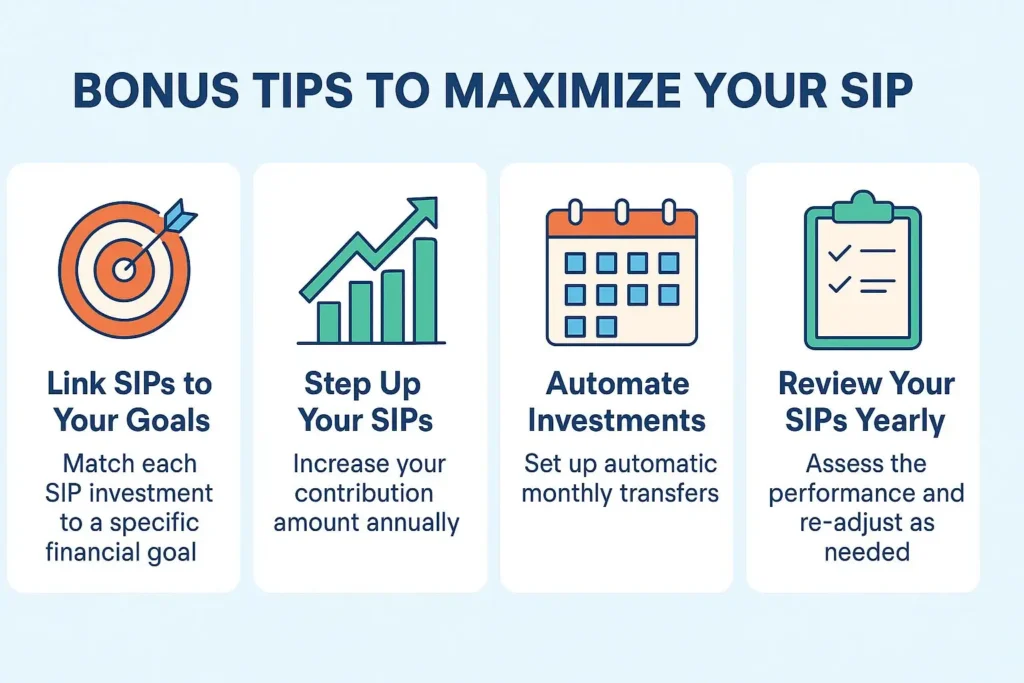Originally Published: February 2025 | Last Updated: July 2025
You have probably heard phrases like, “Invest early,” or “Let your money work for you.” But how do you actually do that when your paycheck is already stretched?
Many people dream of financial freedom but assume it’s complicated or reserved for the wealthy. The truth? It’s not. Systematic Investment Plan (SIPs) are like that dependable friend who consistently helps you build wealth over time. In this post, you’ll discover how a SIP works, why starting early matters, What problem does SIP solve? and practical steps to get going—without the jargon or headaches.
What is SIP?
SIP (Systematic Investment Plan) is a disciplined approach of investing a fixed amount regularly (like monthly or quarterly) into Mutual Funds. Instead of trying to time the market (as unpredictable as guessing tomorrow’s weather), SIP focuses on time in the market to build wealth.
Key Features of a SIP:
• Automated: Linked directly to your bank account.
• Flexible: Start with as little as $25–$100/month.
• Low effort, high reward: Set it and forget it.
• No emotional decisions: Stay invested regardless of market noise.

What Problem Does SIP Solve?
Most people want to invest…
But don’t.
Because they feel:
• They do not have enough money
• They do not know where to begin
• Investing feels risky, complicated, or “only for rich people”
SIP is your answer.
It’s the bridge between “I want to grow money” and “I actually started.”
Investor Pain Point:
“I don’t have a lump sum. I can’t start investing.”
Investor Solution:
SIP lets you start small. Even $50/month. No stress. No timing the market. Just simple, automated wealth-building.
5 Life Problems Systematic Investment Plan Can Actually Solve
No retirement savings Start SIP in an index fund; automate wealth for 25+ years
Kids’ college expenses Start a SIP in a balanced fund early
Can’t afford emergencies SIP in liquid/short-term funds builds safety net
Bad spending habits SIP “pays yourself first” before you spend
Fear of investing SIP removes timing risk; makes investing boring (that’s a good thing!)
How Does SIP Really Work? (The Power of Dollar Cost Averaging)
Markets are like roller coasters—exciting but nerve-wracking. One day, your portfolio’s soaring; the next, it’s dipping. That is where SIP shines. It uses Dollar Cost Averaging to buy more shares when prices are low and fewer when they are high, smoothing out the ride.
Let’s say you invest $100/month in an S&P 500 mutual fund via SIP. In January, the NAV (Net Asset Value) is $10, so you buy 10 units. In February, it drops to $8—now you buy 12.5 units. In March, it’s $12—you buy 8.3 units.
Over time, your average cost per unit drops. This concept is known as Dollar Cost Averaging. You buy more units when prices are low and fewer when high. And that, my friend, is how you beat volatility without trying to predict it.
Why Most People Fail at Investing
Even high earners struggle with wealth building because of:
• Inconsistent investing
• Panic during market dips
• Trying to “time” the market
Systematic Investment Plan neutralizes all that. It builds consistency.
Remember: Wealth does not come from big bets — it comes from repeated habits.
How SIP Fixes This — Even If You Know Nothing
Imagine this:
You set up a $200 SIP. It auto-invests each month. You forget about it.
A year later:
✅ You’ve invested $2,400
✅ Your money has grown
✅ You didn’t panic-sell or overthink
How SIP Helps:
• 🔁 Auto-debit removes human error
• 🪙 Dollar-cost averaging buys units at all prices — removing timing guesswork
• 📈 Long-term growth using power of compounding
The Magic of Compounding— “The Eighth Wonder of the World”
Albert Einstein reportedly called compounding the eighth wonder of the world. Why? Because it turns time into money—literally.
🔢 Let’s do the math: Why Starting Early is Your Superpower
| SIP Amount | Duration | Annual Return | Corpus Value |
|---|---|---|---|
| $100/month | 10 years | 12% | $23,000 |
| $100/month | 20 years | 12% | $99,900 |
| $100/month | 30 years | 12% | $350,000+ |
Now imagine you invest $500/month for 30 years—that grows to $1.7 million+.
And you did not even have to lift a finger. You just showed up every month.
“Compound interest is the most powerful force in the universe.” – Albert Einstein (or at least your future self)
click to get your (systematic investment plan) sip value
How to Start Your First SIP in 5 Simple Steps
Here’s your no-fluff, beginner-friendly roadmap:
✅ Step 1: Set a Financial Goal
• Retirement?
• House down payment in 5 years?
• Kid’s college fund?
✅ Step 2: Choose Your Monthly Amount
Start with whatever’s realistic—$100, $250, or even $50. Just start.
✅ Step 3: Pick a Fund
For US investors, look into:
• Vanguard S&P 500 Index Fund (VOO)
• Fidelity ZERO Total Market Index (FZROX)
• Target Date Retirement Funds (Fidelity, Vanguard)
Use platforms like Vanguard, Schwab, Fidelity, M1 Finance, or Acorns.
✅ Step 4: Automate It
Link your bank account and set a recurring monthly date (ideally after payday).
✅ Step 5: Stay Consistent
Ignore the market noise. Just keep going.
🎯 Pro Tip: Increase your SIP amount by 10–15% every year as your income grows.
How to Choose the Right SIP for YOU
Not all SIPs are created equal. Choosing the right one depends on your goals.
If you’re saving for:
✅ Short-term goals (1-3 years): Opt for bond or money market funds.
✅ Medium-term goals (3-5 years): Consider balanced or allocation funds.
✅ Long-term goals (5+ years): Equity mutual funds offer higher growth potential.
Analogy Time:
Choosing a Systematic Investment Plan is like choosing transportation:
• Short trip? Walk or bike (bond fund).
• Medium journey? Car (balanced fund).
• Long haul? Plane (equity fund for faster growth).
Actionable Steps:
1. Define your goal and how long you will invest.
2. Research funds with solid long-term performance (Morningstar is a great resource).
3. Consider fees—lower expense ratios = more money in your pocket.
4. Use platforms like Vanguard, Schwab, or Fidelity for comparisons.

SIP Strategy for Every Budget
“I don’t have $500 a month!”
No problem. SIP is scalable.
$50/month SIP
✅ Start investing
✅ Build habit
✅ Over 25 years: Can become $95,000 with 12% annual return
$200/month SIP
✅ Ideal for mid-income earners
✅ Grow to $174,000–$200,000 in 20 years
$500/month SIP
✅ Fast-track to financial goals
✅ Become a crorepati/millionaire in 25 years
What Happens If You Skip or Stop SIP Midway?
Unlike gym memberships, Systematic Investment Plans do not charge penalties for skipping a payment. But every missed investment delays your compounding.
Skipping 1 year in a 30-year plan could cost you tens of thousands of dollars in future value. So even during tough months, invest something.
Common SIP Mistakes That Wreck Compounding
⚠ Here are classic blunders you want to avoid:
❌ Starting too late
❌ Stopping during a market crash
❌ Chasing high-return funds without understanding risk
❌ Not increasing SIP amount annually
❌ Investing without a goal
Mistakes are not fatal, but inaction is. Start imperfectly if you must—but start.
SIP v/s One-Time Investment: Which One Wins?
Let’s compare (SIP vs One Time Investments):
Investment Type Pros Cons
SIP Eases volatility, builds discipline, suits salaried folks Slower initial growth
Lump Sum Quick growth if invested during market lows Risky if poorly timed
💡 Best Strategy? Do a hybrid: Start with a lump sum if available, and set up a SIP to keep building.
🔥 BONUS TIPS: SIP Secrets That the Wealthy Swear By
💡 1. Start SIPs Linked to Specific Goals
Instead of random investing, align each Systematic Investment Plan with a concrete goal:
• Child’s education fund
• Dream vacation in 5 years
• Early retirement at 45
• Dream Home or it’s Down Payment
This helps track progress and maintain emotional discipline when the market fluctuates.
🧠 Pro Tip: Label your SIPs in your investment app. “RetireEarly_SIP” sounds far more motivating than “Fund 1.”
💡 2. Step Up Your SIPs Every Year
Start with $200/month? Great. Now increase it by 10–15% annually with your income growth.
📊 Math Time:
A $200 monthly SIP with 12% annual return grows to $200,000 in 20 years.
But if you increase it by just 10% each year, it can grow to over $330,000.
🎯 Little steps = Big outcomes.
💡 3. Automate It. Forget It. Let It Grow.
Set a fixed auto-debit for the 1st or 5th of every month. No temptation to skip. No mental load.
Let compound interest quietly do its magic behind the scenes.
🧘🏻 Financial peace is built on automation.
💡 4. Review Performance Yearly
Set a calendar reminder each year to check:
• Returns
• Fund ratings
• Risk profile
📌 SIPs aren’t “set and forget forever.” They’re “set, automate, and optimize yearly.”

🙋♂ Frequently Asked Questions (FAQs) : People Also Ask Google
❓1. What is a SIP and how does it work?
A Systematic Investment Plan (SIP) allows you to invest a fixed amount in mutual funds periodically—usually monthly. Instead of trying to time the market, you invest consistently, buying more units when prices are low and fewer when they’re high (rupee/dollar cost averaging).
✅ Result? Long-term wealth creation with discipline, not guesswork.
This is why Systematic Investment Plan is often called a smart investment strategy for beginners.
❓2. Is SIP better than a one-time investment?
For most people—yes.
• SIP spreads your risk across time
• Works well during volatile markets
• Builds investing habit with small monthly amounts
📈 For example: $500/month for 10 years at 12% grows to ~$115,000, while a lump sum of $60,000 earns similarly—but with higher emotional risk.
For volatile times and salary-based earners, SIP wins 9 out of 10 times.
👉 For detailed comparison, read: SIP vs Lump Sum Investment: Which Builds Wealth Faster?
❓3. When should I start a SIP?
📅 Today. Not next month. Not next year.
Because in compounding:
“Time > Timing.”
Starting a Systematic Investment Plan in your 20s—even with just $100/month—can yield more than starting with $500/month in your 30s.
✅ The earlier you start, the less you have to invest later.
❓4. Which mutual funds should I choose for SIP?
Here’s a simple breakdown:
• ✅ Beginners: Large Cap Index Funds or Balanced Advantage Funds
• 🧪 Medium risk-takers: Flexi-cap or ELSS Funds (tax benefits too!)
• 🚀 Aggressive investors: Mid-cap or Small-cap (only after understanding the risks)
💡 Always use fund rating tools or consult a fee-only financial planner.
❓5. How much should I invest via SIP monthly?
Start with 10–15% of your take-home salary.
If that feels tight, begin with just $100/month, and step up every year.
🎯 SIP is flexible. You can increase, pause, or stop anytime—just stay committed to long-term goals.
❓6. Can I skip a SIP payment or pause it?
Yes! SIPs are extremely flexible. You can: (there is no penalty)
• Pause or stop payments anytime
• Resume with the same or new amount
• Switch funds without penalty (in most cases)
However, pausing should only be in emergencies.
Do not let short-term discomfort sabotage long-term dreams.
❓7. What if the market crashes—should I stop my SIP?
Absolutely not. In fact, market crashes are a blessing for SIP investors.
Why?
• You buy more fund units at lower prices
• It averages down your cost
• When the market recovers, your gains multiply faster
💡 Warren Buffett-style wisdom: “Be greedy when others are fearful.”
❓8. Is SIP safe? Will I lose my money?
SIP in mutual funds involves market risk—but it’s safer than direct stock investing for beginners.
Here is the safety net:
• Invest in well-rated funds
• Choose longer durations (5+ years)
• Diversify across fund categories
📌 SIPs are not risk-free—but they’re the most stable, proven, and beginner-friendly path to wealth.
❓9. What is the minimum amount for SIP in the USA?
Many US mutual funds or ETFs (via platforms like Fidelity or Vanguard) allow auto-investment starting at $25–$100/month.
❓10. Is SIP safe for beginners?
Yes. SIPs reduce risk over time with rupee-cost averaging. Start with large-cap or index funds.

Conclusion: SIP is Boring… Until It is Life-Changing
In a world where everyone is looking for the next crypto boom, SIPs are the unsung heroes—quietly building wealth, month by month, year after year.
They do not make headlines. But they make millionaires.
So if you’re serious about retiring early, funding your future, or gaining financial freedom—don’t overthink it.
Start your SIP today. Stay the course. And let the compounding magic do the rest.
What To Do Now:
👉 Comment your views and Share this with someone who says, “I can’t invest right now.”
👉 Subscribe to TheFitFinance Newsletter for weekly wealth hacks!
Loved reading it: Now engage with Mutual Fund Calculator (lumpsum investment)







